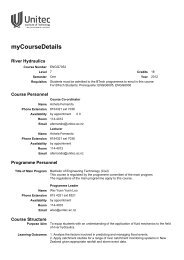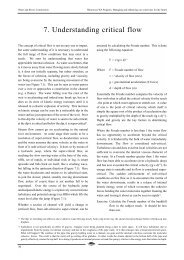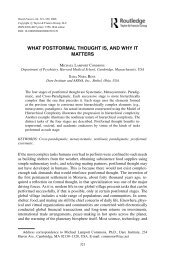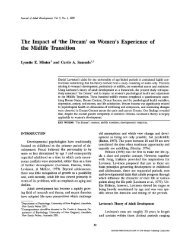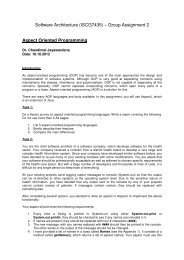Moral Development and Moral Education: An Overview
Moral Development and Moral Education: An Overview
Moral Development and Moral Education: An Overview
Create successful ePaper yourself
Turn your PDF publications into a flip-book with our unique Google optimized e-Paper software.
Current work from within domain theory has sought to explore how the child's concepts of moral<br />
<strong>and</strong> conventional regulation relate to their developing underst<strong>and</strong>ings of personal prerogative <strong>and</strong><br />
privacy. This work is exploring how children develop their concepts of autonomy <strong>and</strong> its relation to<br />
social authority. This has led to a fruitful series of studies of adolescent-parent conflict with important<br />
implications for ways in which parents may contribute to the healthy development of youth (Smetana,<br />
1996). This work is also being extended into studies of how adolescents perceive the authority of<br />
teachers <strong>and</strong> school rules.<br />
V. <strong>Moral</strong> <strong>and</strong> Social Values <strong>Education</strong><br />
The implications of domain theory for values education are several. First, the identification of a<br />
domain of moral cognition that is tied to the inherent features of human social interaction means that<br />
moral education may be grounded in universal concerns for fairness <strong>and</strong> human welfare, <strong>and</strong> is not<br />
limited to the particular conventions or norms of a given community or school district. By focusing on<br />
those universal features of human moral underst<strong>and</strong>ing, public schools may engage in fostering<br />
children's morality without being accused of promoting a particular religion, <strong>and</strong> without undercutting<br />
the basic moral core of all major religious systems.<br />
Second, educational research from within domain theory has resulted in a set of<br />
recommendations for what is termed "domain appropriate" values education. This approach entails<br />
the teacher's analysis <strong>and</strong> identification of the moral or conventional nature of social values issues to<br />
be employed in values lessons. Such an analysis contributes to the likelihood that the issues<br />
discussed are concordant with the domain of the values dimension they are intended to affect. A<br />
discussion of dress codes, for example, would constitute a poor basis for moral discussion, since<br />
mode of dress is primarily a matter of convention. Likewise, consideration of whether it is right to steal<br />
to help a person in need, would be a poor issue with which to generate a lesson intended to foster<br />
students' underst<strong>and</strong>ings of social conventions. A related function of the teacher would be to focus<br />
student activity (verbal or written) on the underlying features concordant with the domain of the issue.<br />
Thus, students dealing with a moral issue would be directed to focus on the underlying justice or<br />
human welfare considerations of the episode. With respect to conventions, the focus of student<br />
activity would be on the role of social expectations <strong>and</strong> the social organizational functions of such<br />
social norms.<br />
On the basis of this kind of analysis teachers are also better enabled to lead students through<br />
consideration of more complex issues which contain elements from more than one domain. By being<br />
aware of the developmental changes that occur in students' comprehension of the role of social<br />
convention, <strong>and</strong> related changes in students underst<strong>and</strong>ing of what it means to be fair or considerate<br />
of the welfare of others, teachers are able to frame consideration of complex social issues in ways<br />
that will maximize the ability of students to comprehend <strong>and</strong> act upon the moral <strong>and</strong> social meaning of<br />
particular courses of action.<br />
The best sources for discussion of domain appropriate education, along with guidelines <strong>and</strong><br />
examples for how teachers may select materials from existing school curricula from which to generate<br />
lessons <strong>and</strong> practices which will foster students' development within both the moral <strong>and</strong> conventional<br />
domains may be found in: Nucci, L. & Weber, E. (1991) "The domain approach to values education:<br />
From theory to practice" In W. Kurtines & J. Gewirtz (Eds.) "H<strong>and</strong>book of <strong>Moral</strong> Behavior <strong>and</strong><br />
<strong>Development</strong> (Volume 3: Applications)pp. 251 - 266). <strong>and</strong> also in: Nucci, L. (1989) "Challenging<br />
Conventional Wisdom About <strong>Moral</strong>ity: The Domain Approach to Values <strong>Education</strong>." In L. Nucci (Ed.)<br />
"<strong>Moral</strong> <strong>Development</strong> <strong>and</strong> Character <strong>Education</strong>: A Dialogue" Berkeley: McCutchan.<br />
Examples of such materials <strong>and</strong> practices will be provided in coming months on the FEATURED<br />
PRACTICES segment of this WEB site.<br />
VI. Carol Gilligan <strong>and</strong> the <strong>Moral</strong>ity of Care<br />
A second major critique of Kohlberg's work was put forth by Carol Gilligan, in her popular<br />
book, "In a Different Voice: Psychological Theory <strong>and</strong> Women's <strong>Development</strong>" (1982). She<br />
suggested that Kohlberg's theories were biased against women, as only males were used in his<br />
studies. By listening to women's experiences, Gilligan offered that a morality of care can serve in the<br />
place of the morality of justice <strong>and</strong> rights espoused by Kohlberg. In her view, the morality of caring<br />
<strong>and</strong> responsibility is premised in nonviolence, while the morality of justice <strong>and</strong> rights is based on



